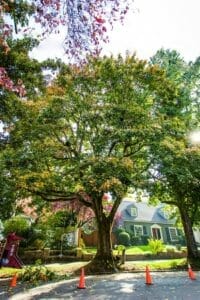Fall is here! With the new season comes new tasks for Portland tree care. Read on for our Portland certified arborist’s top five tips for autumn tree care. We will also review common trees in the Portland area, with a focus on particular routine tree maintenance needs our local trees require.
Caring For Your Yard this Fall: Portland Tree Pruning and More.
As fall arrives, we all think about raking leaves and cleaning out garden beds. But there are also important tree jobs to be done.
- Structural Pruning. Structural pruning is important for several reasons. Primarily, structural pruning prevents non-canopy branches from growing too large, which diminishes the chance of fallen limbs in winter storms. With structural pruning, and arborist spaces out the main branches along a dominant trunk, with the idea that a single strong trunk can withstand harsh weather.
- Ornamental Pruning. This type of pruning is done to maintain or reduce plant size, to remove unwanted growth, to remove dead, diseased or broken branches, to give the plant an artistic form, and to stimulate fruiting and flowering.At this point you may be asking, “What about pruning fruit trees?” The best time to prune fruit trees is in the winter, because that’s when they go dormant. Fruit tree pruning includes many of the aspects mentioned above, but also strives to improve air flow and increase light penetration. The pruning is directed so that the tree’s energy is directed into growing or ripening fruit. If you’re interested in learning more about fruit tree trimming, Portland has several educational organizations dedicated to teaching the public about this aspect of landscape care.
- Maintain Equipment. Keep your pruning shears in tip-top shape by properly sharpening and oiling them. Review your lawn mower’s health. Make any necessary repairs to garden equipment. Of course, maintenance may also be done in the winter, but we prefer to do it in the early fall, so that fall gardening efforts are as effective as possible.
- Mulching. This is a classic fall task. One way to mulch is to rake up leaves and pile them over garden beds. The nutrients in the leaves will benefit the underlying soil, and the mulch will also provide a blanket of protective warmth over the winter. However, if you find this simple approach too messy-looking, you can also choose to mulch with other materials, such as straw, bark, or hulls.
- Planting. Last but not least is fall planting. Many Oregon gardeners are happy to be back in the garden planting after a long, hot and dry summer. This is a great time to reinvigorate the fall veggie crop, plant new perennials, and of course, prepare and plant new trees. Planting in fall is great because it provides time for plants to set new roots before and over the winter. Fall is also an excellent season for tree planting. Portland gardeners must keep in mind that our area’s autumn can be dry, and new plantings always require thorough watering.
Other fall garden tasks include aerating, seeding, conditioning and fertilizing your lawn as needed, and winterizing your irrigation system. Don’t forget this last task, or your system could freeze and break over the winter. Call us for irrigation system installation, maintenance, and winter tree care in Portland, Oregon.
In the next section of this post we look at some common Oregon trees.
Oregon Trees (Our Great Delight!)
Hardwoods. Deciduous hardwood trees drop their leaves in the fall, and dealing with piles of windblown, or wet leaves is a priority for municipalities and homeowners alike.
- Bigleaf Maple. This is the largest of the maples, and very common in western Oregon. At maturity a Bigleaf Maple can reach over 100 feet in height. They are often quite wide as well, so their leaf drop is nothing to take lightly.
- Red Alder. This is the most common of the broadleaf deciduous trees in Oregon, growing from 30 to 120 feet tall at maturity. The Red Alder is also the largest species of Alder in North America.
- English Walnut. This is a fast growing tree that can bear nuts as early as 4 to 8 years after planting. The tree grows 40 to 60 feet tall, and also grows very wide. The tree’s leaves and walnuts create problems for lawns.
- Oregon White Oak. Luckily oaks don’t drop their leaves until the winter or spring, so they don’t cause as many problems, but like other larger trees, they can be susceptible to damage from high winds so it makes sense to have them pruned regularly. Also, be careful with soggy soils. These can be harmful to the root systems of oak trees, making mature trees prone to uprooting.
Conifers. Oregon’s conifers dominate the landscape in the winter months. They don’t drop leaves but rather branches and needles. These need to be included in your fall clean up as well. Large conifers such as Douglas firs need to be trimmed on a regular basis to prevent large branches from falling on your property. Giant sequoia, ponderosa pine, and western red cedar are other common conifers found in the greater Portland area.
Contact a Portland arborist to discuss your pruning needs. Don’t try to take on risky pruning projects yourself; instead, leave them in the hands of a professional. At UFP, our arborists are fully certified and insured. We know that your trees are important to you, and also that pruning is a process that takes time to master. We use the best equipment and materials in order to ensure that our job is professional and reliable. At Urban Forest Pro, you can be positive that you are truly in the hands of a qualified expert. Call us today for Portland tree services.